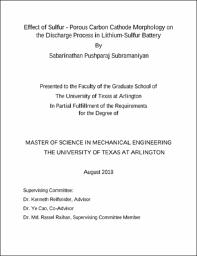
ATTENTION: The works hosted here are being migrated to a new repository that will consolidate resources, improve discoverability, and better show UTA's research impact on the global community. We will update authors as the migration progresses. Please see MavMatrix for more information.
Show simple item record
| dc.contributor.advisor | Reifsnider, Kenneth | |
| dc.contributor.advisor | Cao, Ye | |
| dc.creator | Pushparajsubramaniyan, Sabarinathan | |
| dc.date.accessioned | 2019-08-27T20:01:37Z | |
| dc.date.available | 2019-08-27T20:01:37Z | |
| dc.date.created | 2019-08 | |
| dc.date.issued | 2019-08-14 | |
| dc.date.submitted | August 2019 | |
| dc.identifier.uri | http://hdl.handle.net/10106/28607 | |
| dc.description.abstract | In the present era, Lithium-ion (Li-ion) batteries are most commonly used in all electronic devices, but the demand for alternative energy increases rapidly due to the catastrophic climate caused by excess use of fossil fuels in automobiles. Li-ion batteries cannot fully satisfy the need as its theoretical capacity is low, and the cathode cost is high. On the other hand, Lithium-Sulfur (Li-S) battery meets the requirement with the highest theoretical capacity of Sulfur 1672 mAh/g. Lithium anode and Sulfur cathode together form to be having the highest energy density. The highest energy capacity of Sulfur is achieved by the conversion of Elemental Sulfur to Lithium Sulfide. Even-though Li-S cell shows the highest theoretical capacity, and the experimental results show much less capacity due to various challenges, which include low cathode conductivity, polysulfide dissolution in the electrolyte and shuttle effect. Although different methods have been developed both experimentally and mathematically to increase the capacity of the cell, further understanding of the mechanism of the Li-S cell is necessary. Hence in this research work, a mathematical framework has been developed in continuum scale to demonstrate the reaction mechanism of the Li-S cell along with all the electrochemical reactions and chemical reactions that include the precipitation and dissolution during the discharge condition. As active surface area loss caused by Li2S (insulator) precipitation in Li-S cell has a significant impact on the capacity of the cell, the effect of the active surface area of the cathode during discharge condition was studied. Studies on the effects of initial porosity and its effects on the capacity of the Li-S cell are explained.
Later, a pore-scale model of Li-S cell was developed considering the electrochemical reactions (without precipitation and dissolution) and by applying the insulating nature of Sulfur in the Li-S cell, and the results are compared with the continuum scale modelling. | |
| dc.format.mimetype | application/pdf | |
| dc.language.iso | en_US | |
| dc.subject | COMSOL | |
| dc.subject | Lithium-Sulfur | |
| dc.subject | Multiphysics modelling | |
| dc.subject | Discharge-behavior | |
| dc.title | Effect of Sulfur - Porous Carbon Cathode Morphology on the Discharge Process in Lithium-Sulfur Battery | |
| dc.type | Thesis | |
| dc.degree.department | Mechanical and Aerospace Engineering | |
| dc.degree.name | Master of Science in Mechanical Engineering | |
| dc.date.updated | 2019-08-27T20:01:37Z | |
| thesis.degree.department | Mechanical and Aerospace Engineering | |
| thesis.degree.grantor | The University of Texas at Arlington | |
| thesis.degree.level | Masters | |
| thesis.degree.name | Master of Science in Mechanical Engineering | |
| dc.type.material | text | |
Files in this item
- Name:
- PUSHPARAJSUBRAMANIYAN-THESIS-2 ...
- Size:
- 2.203Mb
- Format:
- PDF
This item appears in the following Collection(s)
Show simple item record


